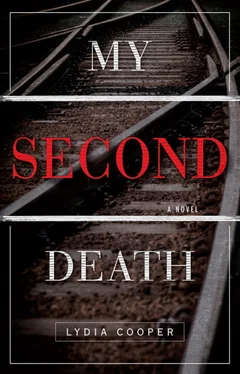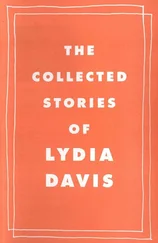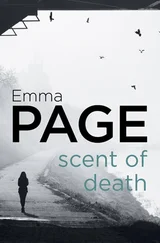Instead, I go running. But this time I’m not running for the purity of it, for the escape. I’m running with a destination in mind. The huntress stalking her prey.
No one from the soup kitchen has called. I didn’t really expect them to. So I need to follow up on Desiree of the Drugs and the Backpack myself.
The air tastes crystalline, gusts rattling bare branches. A freezing mist crusts my skin like a shell of cold pearls. My sneakers strike the concrete with hollow thuds, loud in the preternatural stillness. I jog through the deserted campus and head south through abandoned parking lots behind the performing arts center, down a curving road with no cars idling at the forlorn red lights.
The southern sector of campus is bifurcated from the main campus by a valley through which runs a train track. The curving road I follow loops down under an overpass, and the tracks spool out of shadow. Under the overpass a blue tarp is folded next to a black trash bag. Some homeless person’s lair.
I once heard a speaker at the university talking about the homeless population in Akron. He claimed that many of them sleep rough under the bridges in winter. And it looks as if he may actually be right. The speaker also claimed that the city of Akron is plagued by the homeless but that seemed to me a strange assertion. I doubt that most upstanding citizens have ever seen or spoken to a homeless person, except for the ones who lurk by freeway exit and entrance ramps with their cardboard signs, and the most interaction that occurs at those interchanges is a strenuous avoidance of eye contact. It seems to me that the homeless may instead be plagued by the rest of Akron’s population. I stop and look at the accoutrements of a migratory life. The thick smell of unwashed body, but a certain cleanness to the life lived pressed up against the shadow of not-being. I wonder if the person whose sole shelter is a blue tarp will die of exposure. It annoys me that normal people have already decided that this individual, this human-shaped absence, can die, but that I with my morbid fantasies should be despised. Sympathy is illogical, but if people are supposed to be sympathetic they should at least practice it consistently.
I wander for a long time, hunting down the trace of the homeless. But I don’t see any sign of Desiree. I think about how easily people die of exposure, of disease. How fundamentally not hard it is to be killed, through murder or through apathy.
After my futile search for my one link to 411 Allyn Street and the corpse inside, my witless witness, Desiree of the Dora the Explorer backpack, I head back to the apartment to shower and change and go in search of my only other puzzle piece: Aidan’s past.
When I climb into the Chevelle, I slide the key into the ignition and for a second just listen to the throaty rumble of the engine. It’s a new car with the manifold replaced. I think it even gets better gas mileage, but it’s hard to tell when a good day averages about seventeen miles to the gallon. I let the engine idle for a minute, exhaust billowing out behind the car and smudging the sky like ash. I want to know why Aidan hasn’t told me who he suspects in his mother’s death, which character on the Clue board of his past he thinks he’s protecting. There isn’t a logical reason for him to be so shy about it. As he said, it’s not like I’ll care one way or another. But for whatever reason, it doesn’t seem like he’s going to tell me.
I power my way through Akron’s salt-whitened streets, looking for a road called Brown. The house fire from which Aidan’s mother’s corpse was dragged a decade ago occurred at 2136 Brown Street. The street itself is narrow, a cracked sidewalk running jaggedly through mounds of grayed snow studded with upturned trashcans and crumpled beer cans. The houses perch on small stamps of thinning grass, porches sagging, roofs rain-buckled and sun-bleached. Because this area is crowded with low-income housing, I am surprised to find the lot without any problems. The house has not been rebuilt. Aidan’s old house was a yellow Cape Cod, and the shell of the structure is now singed and streaked with black, a gaping hole in the roof near the chimney. The plywood tacked across the door has been stamped with large pink letters that read Condemned.
There is an obvious synchronicity between Aidan’s decade-old murder and the more recent corpse, but so far I can’t see any sense behind the inexplicable parallels.
I pull the Chevelle over to the side of the road and park. The bitter air nips at my skin. Hugging my arms against my chest, I climb through overgrown weeds to the front door. A black-painted mailbox sits above a white doorbell. I lift the lid of the mailbox, but it’s empty. I breathe in deeply, but the house does not smell of char or death.
I step backwards off the front porch and crane my head back, studying the house. It’s a typical layout, so the floor plan probably involved two bedrooms, a kitchen, a bathroom, and a living room on the first floor, with a narrow attic above and a basement below. With three kids, two girls and one boy, the extra bedroom on the ground floor probably belonged to the girls, the attic above to the boy.
The report claimed that the fire had two points of origin. Given the singe near the chimney, it is safe to assume that one point was the attic. The other point was the master bedroom, facing the street on the left-hand side of the house. The wall here is buckled, the siding blackened, the window long ago shattered, boarded over, and taped shut.
I turn and head back to the car. My face is numb and my nose drips.
“Excuse me? Excuse me.”
I stop and turn around, wiping my sleeve under my nose.
A fat woman has come out of a tiny brick house to the left of 2136 Brown. She is wearing pink slippers and hugging a faded pink cardigan around her breasts, which bounce like melons in a sack as she waddle-runs to me.
“Excuse me!”
I wait and she arrives finally, panting. The top of her head barely comes up to my shoulder and I can see pale skin through the garishly-dyed red hairs sprouting from her scalp. When she moves her clothes give off a faint odor of cat litter.
“Hi,” she says, wheezing. “I saw you looking at that house.”
I don’t say anything. My fist, clenching the ignition key, rests on the car door’s frame.
“I’ve lived here for twenty-three years. I used to be neighbors with the family. A very sweet family. It was terrible what happened.” She stops and looks up at me as if expecting me to comment. When I don’t, she sucks in a breath and says, “If you don’t mind me saying it, I don’t think gawking is very respectful. That woman was a saint.”
A light flickers in my head. “Are you Judith Greene?”
She says, “Oh! Did you know her?”
After a slight pause, I say, “Yes. I was a — she was my therapist.”
Judith Greene tilts head. The cream-colored rolls of fat on her neck dimple. “Oh, I’m sorry I said you were disrespectful! I thought — I mean, you know how kids are these days. Every Halloween it’s the same, you know? Do you want to come in? It’s real cold out.”
“No. Thanks. How well did you know her?”
Judith Greene’s bulbous eyes stare up at me, the whites branched with veins and tinged pink, the irises the color of pale amber, yellow washed in gold. “We were like one soul trapped in two bodies,” she says.
Her whole body quivers in its pink sweater.
We stand in silence, our breath startling and dark in the clear sky.
“What about her kids?”
She says, “Yes, they were beautiful children. Miranda was so talented, and that sweet little boy. He used to watch my cats. I wish I knew what became of them. It was so terrible, what happened. I think we all needed to — you know, move on . And you know, with the divorce, they were already living with their father.”
Читать дальше












